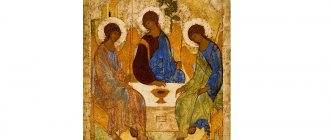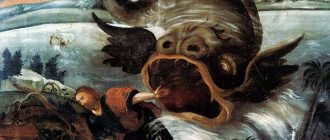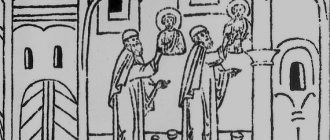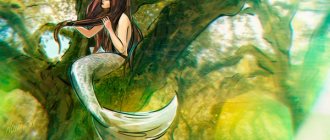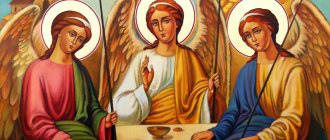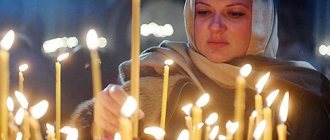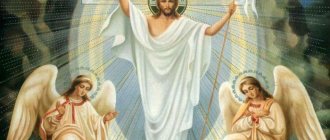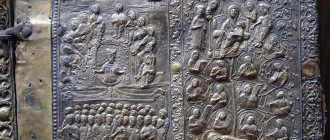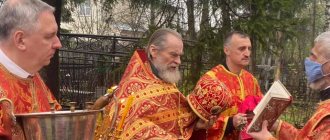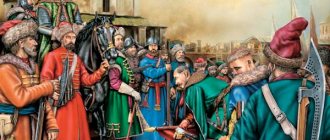Any church holiday is, if you like, a multi-layered pie with a wide variety of fillings. There are all flavor combinations here - from classic to original.
So the holiday of Trinity fits perfectly into these patterns. Church canons, biblical stories and, of course, folk traditions - all this is imprinted in cultural memory.
And also on the canvases of immortal paintings that have survived to this day. Famous photos of the Trinity, legendary icons, masterpieces of world painting - all this can be seen right now.
Zyryan Trinity
Who doesn't know the icon of the Holy Trinity? Andrei Rublev immediately comes to mind, although, of course, there are other iconic images.
Here, for example, is the Zyryan icon of the Trinity. It was created back in the 14th century by Komi-Zyryan craftsmen. And the inscriptions on the canvas are made in the ancient Perm language. The photo of the icon shows that a plant is depicted on top of the Holy Trinity - this is a symbol of the oak of Abraham.
And what does oak have to do with it? This is discussed in detail in the next section.
Old Testament Trinity 16th century
It is interesting that the first symbolic meeting with the Trinity is described in the Old Testament, many centuries before the appearance of Christ and the Holy Spirit on earth.
Everyone knows Abraham, the ancestor of the Israeli people. His wife Sarah could not conceive for a long time, although God promised Abraham a huge offspring. This paradox was easily resolved thanks to a miracle: a 90-year-old woman became pregnant by a 100-year-old man, and the family finally had their first child.
And exactly a year before this event, three very unusual travelers came to Abraham. The owner received them very hospitably, although for a long time he did not realize that they were messengers of God.
Everything went according to classical canons - the guests were enjoying the meal, when suddenly one of them said that in a year Abraham would have a son. It was hard to believe, and Sarah, who unwittingly overheard the conversation, even grinned. However, in the end everything happened exactly as the envoys said.
It is believed that these were three angels who were a prototype of the triune God - Father, Son and Holy Spirit. These legendary events took place in a sacred oak grove called Mamre.
That is why many icons of the Holy Trinity always depict an oak branch.
On the left and right, as you might guess, are Abraham and Sarah. They were called to serve the Lord, because he performed a great miracle for them - at such a respectable age, the couple had their first (and only) son. And in the center of the canvas we see the image of the triune God: Father, Son and Holy Spirit.
If we talk about who is depicted on this icon of the Holy Trinity, then everything corresponds to the church canons: on the left is God the Father (first hypostasis), in the center is God the Son (second hypostasis) and on the right is God the Holy Spirit (third hypostasis).
Miracles icons
The divine image has been known since ancient times for its miraculous influence, which has historical confirmation, one of which is associated with the Russian ruler Ivan the Terrible:
On the eve of his departure to war with the Kazan kingdom, Ivan the Terrible went to the miraculous face, which was located in the Trinity-Sergius Lavra. From the surviving evidence, it became known that Ivan the Terrible asked for a very long time and sincerely in prayer before the icon for the granting of protection and blessing for victory in a military campaign.
In that campaign, Ivan the Terrible actually won a victory, and when he returned home, the king again headed to the Lavra, where he spent a long time offering thanks in prayer to the Almighty for help and protection.
Holy Trinity in existence
Since this story is described in the book of Genesis (chapter 18), below is a photo of the icon of the Holy Trinity in Genesis. This is a real canvas, which symbolically depicts an oak tree from the sacred place of Mamre, and the conversation of Abraham and Sarah at the table with the triune God.
But the meaning of this icon with the Trinity in existence is somewhat different. On the canvas we see that same promised son - a boy named Isaac. The Lord fulfilled his vow and performed a miracle.
And today it has not changed at all, which means that miracles happen in our century.
Information space of the Orthodox Christian
In order to avoid falling for the tricks of unsavory Internet sites, it is better to download the necessary information from official Orthodox resources. The Orthodox book still remains a verified source. Fortunately, there are enough worthy publishing houses. Listen to the advice of the clergy. Many priests are active on social networks. They have their own pages and profiles, and you can contact them directly with questions.
We recommend watching Orthodox media: Spas and Soyuz TV channels, Vera radio, Foma magazine. These are leaders of the information space for believers, regardless of their degree of church membership or knowledge. Everyone there will find necessary and easily digestible spiritual “food” for their soul.
Convenient, transparent formats for communication with the congregation. Strong confessors, clear explanations of the Holy Scriptures, practical advice for different ages, analysis, analysis of mental and spiritual issues. This is only a small part of the topics covered by the fascinating, educational media of Orthodox information. Choose the categories of eternity, and they lie exclusively on the spiritual plane.
Old Testament Trinity with Walking
This icon with the Holy Trinity, the photo of which is shown below, has a similar meaning. Those legendary travelers obviously came from afar. And after meeting Abraham, they disappeared as quickly as they appeared.
This walk became a good sign, because exactly a year later the long-awaited heir actually appeared in the family. The Old Testament icon of the Trinity with walking (or in walking) conveys this joy well. Moreover, here the plot is complemented by how the son Isaac sacrifices a ram.
This image reflects the famous story of how Abraham nearly stabbed to death his own son, whom God required to be sacrificed. Abraham almost carried out this order, but an angel stopped him in time.
In this way, the Lord tested the faithfulness of his servant - and the result was beyond all expectations. And then, as a sacrifice, they slaughtered the very ram on which the depicted Isaac sits.
History of the divine shrine
The plot of the icon of the Holy Trinity is based on the biblical story of Abraham’s meeting with three travelers. Strangers, who were Angels, appeared to the founder of all nations to inform him of the imminent birth of his son, Isaac. Initially, the image was of a purely eventful nature and was called “The Hospitality of Abraham,” but over time, the elements of the composition began to be filled with meaning, and the shrine was given the name “Appearance of the Holy Trinity.” That is why today you can find two options for writing the face:
- all three angels are depicted as equal;
- the head of the central angel is crowned with a large halo, as a sign of God the Father.
The author of this masterpiece is the famous Russian icon painter Andrei Rublev. The estimated date of creation of the icon is at the beginning of the 15th century, but the first mention of it is found in the documents of the Stoglavy Cathedral of 1551.
The author of the image is the famous Russian icon painter Andrei Rublev
The image was painted at the request of the rector of the Holy Trinity Lavra, as a sign of respect to Sergius of Radonezh. Most historians adhere to this version, but there is another opinion. It says that the shrine was created for a new cathedral, which was erected on the site of the wooden Trinity Church, which was damaged by fire.
Like all Orthodox icons, the Holy Trinity has its own date of veneration. The celebration takes place on the 50th day after Great Easter. It was then, according to biblical legends, that the Holy Spirit appeared to the disciples of Christ.
Trinity of Andrey Rublev
So, it’s clear who is depicted in the Holy Trinity icon, but what does it mean? The answer can be found in the famous painting by Andrei Rublev, which is also known as “The Hospitality of Abraham” (15th century).
This is a classic image, the contemplation of which really makes you think about the eternal. If you look at the icon for a long time, you get the impression that the same face is drawn.
This has a deep meaning: the Father, the Son and the Holy Spirit are the triune God. One is like three, and three is like one - here it is, the incomprehensible essence of the divine nature.
Non-canonical images
Many believers have seen an icon called “Trinity of the New Testament.” It depicts a gray-haired old man, Christ and a soaring dove. However, such stories are strictly prohibited in Orthodoxy. They violate the canonical prohibition according to which God the Father cannot be depicted.
In accordance with the Holy Scriptures, only symbolic images of the Lord are permissible, for example, in the guise of an angel or Christ. Anything else is heresy and should be removed from the homes of godly Christians.
The dogma of the Trinity, which is very difficult to understand, looks very accessible in such non-canonical icons. The desire of ordinary people to make something complex simple and clear is understandable. However, you can purchase these images only at your own risk - the cathedral decree prohibits them, even consecrating them is prohibited.
Trinity in frame (icon)
And this image is not even a picture, but a kind of golden case - a frame, under which the well-known icon of Andrei Rublev is hidden. It would seem, who and why needed to hide this work of art under a layer of gold?
The idea came to the mind of Ivan the Terrible, who did not want the shrine to be visible to the eyes of even his immediate circle. It is interesting that soon after the death of the tsar, his successor Boris Godunov ordered to cover the image with another layer of gold, as well as diamonds and sapphires.
It is symbolic that such a “case” lived for more than 4 centuries and largely preserved the classical image from the destructive effects of time. But nevertheless, the shrine itself turned out to be eternal, and not the golden layer.
In 1904, the sediment was removed by the restorer Vasily Guryanov, and then the very Trinity that many people know today, even those who are far from religion, appeared to the eyes of everyone.
Well, “life is short, art is eternal” (Latin: “Vita brevis, ars longa”), as the ancients said.
Return of color
In the history of the Trinity icon, an important stage was the rediscovery of long-familiar material. Several decades ago, restorers learned how to remove drying oil from old images. V. Guryanov, under a small fragment of the “Trinity,” discovered a surprisingly vibrant shade of blue (the color of the robes). A whole wave of visitors followed.
But the monastery was not happy about this; the icon was hidden under a massive frame. Work has stopped. Apparently, they were afraid that there would be people who wanted to spoil the shrine (this happened with other famous images).
The work was completed after the revolution, when the Lavra itself was closed. The restorers were amazed by the bright colors that were hidden under a dark coating: cherry, gold, azure. One of the angels is wearing a green cape, in places you can see pale pink. These are heavenly colors that indicate one of the meanings of the Trinity icon. It seems to call the praying person back to where unity with God is possible, this is a real window into another world.
Non-canonical images of the Holy Trinity: Coronation of the Mother of God
In general, nothing is said about the coronation of the Virgin Mary, as well as Jesus or the Holy Spirit. However, Our Lady is recognized as a saint by all branches of the Christian religion. And according to the beliefs of believers, she was also ascended to heaven immediately after death.
It was then that her coronation took place. And this event is one way or another reflected in the church calendar. Orthodox Christians, for example, celebrate the Dormition of the Virgin Mary. This happens every year on August 28th according to a new style.
The plot of the coronation has been interpreted in different ways. For example, the canvas by Diego Velazquez depicts how Mary is crowned by the Father and the Son.
And Ridolfo Ghirlandaio depicted Christ himself crowning the Virgin Mary in heaven. And in honor of this event, the angels play solemn music.
Worship of the Holy Trinity
And this is no longer just a photo of the Holy Trinity, but a real panorama that, without exaggeration, you can look at for hours. The work of Albrecht Dürer, created by him in 1511, is today kept in the famous Vienna Kunsthistorisches Museum.
In the main plan is the crucifixion of Christ. A little further is the Father, who, out of great mercy, himself gave the Son as a sacrifice for the salvation of all mankind. Even higher, in the heavens, the Holy Spirit hovers in the form of a dove. It evokes a feeling of serenity and freedom. There, in heaven, we can see numerous angels.
Well, a little lower on two tiers there are people who worship the Trinity. These are the saved souls who remained in heaven after the Last Judgment - now they will forever be blissful and glorify the triune God.
Masaccio's fresco "Trinity"
But this fresco is almost 600 years old. It was painted by the famous Florentine artist Masaccio, who was given a very short life - the painter did not live to be 27 years old. However, this did not stop him from perpetuating his memory in the form of priceless masterpieces of world painting.
The fresco depicts Christ crucified, but unlike most such images, we see the Father supporting him in the background.
Icon of the Trinity by Hieronymus Cocido
The Trinity plot was often used by medieval and Renaissance masters to create magnificent paintings. They depicted the faces of the triune God, the crucifixion of Christ, and the service of Abraham to three angels.
These images, of course, do not belong to icons. Moreover, even among secular paintings they can be found much less often than, for example, the coronation of the Virgin Mary.
The tradition of painting three faces in one person was started by the late Renaissance master Hieronymus Cocido. Such pictures were intended to show the triune nature of God and, as it were, to explain to non-believing people this most important position of the Christian faith.
However, this style never caught on. Of course, everyone has different tastes, but in this case you can feel a clear dissonance.
Thus, the question of which Saints are depicted on the Trinity icon is not entirely correct. After all, the canvases always depict God himself in his three faces - Father, Son and Holy Spirit. And Abraham and Sarah are his faithful servants who remained devoted to the Lord to the end.
Therefore, the icon of the Holy Trinity is not only an image of the triune God, but also visible proof that the Almighty fulfills His promises, which means that all our bright desires will come true.
